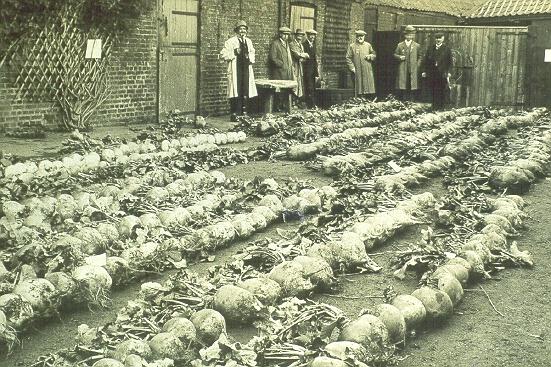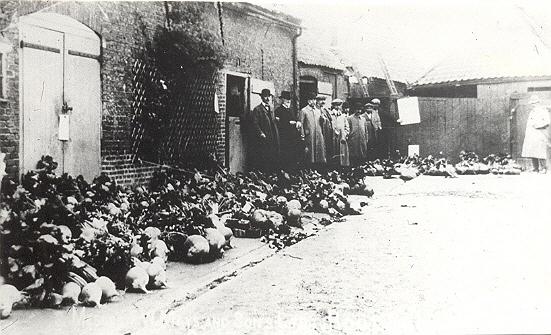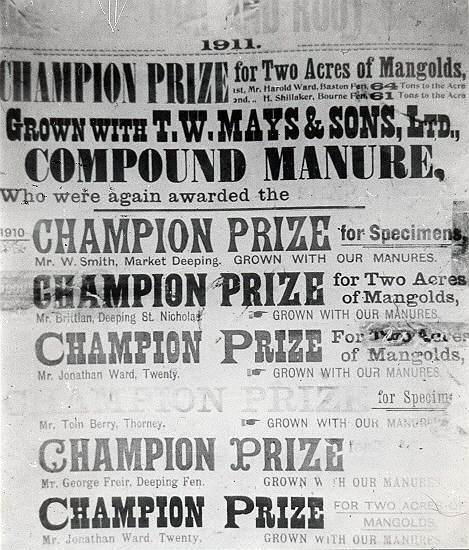|
Root crops and the annual Root Show
Most of the shows and demonstrations in Bourne in past times were related to agriculture, to demonstrate new machinery and techniques, and to show off what had been achieved on the land. As most farmers grew root crops, the annual Root Show was a particular favourite and the picture above was taken at this event on Thursday 29th October 1914 with prize specimens on display as a mark of achievement for those farmers who had grown them and as an incentive for those who had not done quite so well. Mangolds, or mangels, were grown extensively throughout the fens at that time, the best crops being obtained in the East Fen and in Deeping Fen. They were frequently sent away for use by cow keepers in large towns. By the close of the 19th century, an ordinary crop of mangolds was yielding 20 tons to the acre, a good crop 40 tons and even up to 60 tons had been recorded and with sale prices varying from 14s to 20s per ton, the profitability appealed to most growers with suitable land. Mangolds were also occasionally grown for seed and in 1893, a crop from 26 acres realised £2,000, equal to £80 an acre, a highly lucrative return in those days. Turnips were grown for sheep feeding and frequently allowed to stand for seed. The yield was from three to four quarters per acre, 4½ quarters being considered a very good crop. The price realised was around £1 1s a bushel but in 1894 it had fallen to about 12s a bushel. The seed was sown in July, the turnips being taken up and re-planted in November and the seed was ready for harvesting in July. The best method employed before mechanisation was by dibbling the turnips in at intervals of 18 inches apart, a man and a boy doing about a third of an acre in a day. They were sometimes put in with a spade and occasionally by merely planting in a furrow made by the plough and then covered by splitting the ridge. Carrots were also grown to a considerable extent on peat and silty lands, an average crop yielding about 15 tons to the acre and crops of 20 tons were occasionally gathered, the price being about 20 shillings a ton. Sugar beet was not cultivated on a commercial scale in this country until the mid-1920s although it soon became a most successful industry. The crop had been tried in the fenland east of Bourne but the results at that time were not good because it grew too coarse and its cultivation was abandoned until the early 20th century when renewed efforts brought a brighter prospect. It was then successfully raised and although Britain's ravenous demand for sugar was mostly fulfilled by European beet imports until shortly after 1900, successful sugar beet production in areas such as that around Twenty provided the nation's sugar requirements during the First and Second World Wars. In 1925, the possibility of opening a processing factory at Bourne was considered by the Anglo-Scottish Beet Corporation, forerunners of the British Sugar Corporation, later British Sugar. The project was fully supported by Bourne Urban District Council and a sub-committee was appointed to consider the project and to meet Bourne Waterworks Company to ensure that there would be an adequate supply of water for the processing procedures. But no agreement was reached and the factory was eventually built at Spalding whose council guaranteed an adequate supply of water which ironically, emanated from Bourne. The annual root show at Bourne began in 1908, sponsored by Messrs T W Mays and Sons Ltd, chemical manure manufacturers and bone crushers, as they were then described, no doubt as a means of demonstrating how much better crops would be if their fertilisers were used in the growing process. The event above was photographed on Thursday 29th October 1914 at Coales' Yard in Abbey Road [later known as Hodgkinson's Yard] and the Stamford Mercury reported the following week: "There was a rather larger entry than usual and the judges commented upon the splendid quality of the exhibits." Prizes were awarded in all categories and on this occasion they included a golden tankard for the best golden globe mangels which went to Mr J Freeman of Billingborough, cash prizes for the best yellow globe mangels to Mr W J Bridgeman of Bourne Fen (£1) and Mr N Allen of Uffington (10s) and for the best swede turnips to Mr W Measures of Tallington (£1) and Mr A Simmonds of Colsterworth (10s). The scope of the show was extended in 1918 when, in addition to the usual awards for mangolds and turnips, special prizes were also given for the best specimens of potatoes and the best sample of barley grown with the company's manure. When the show was held the following year, in October 1919, Mr Thomas Mays, senior partner in the firm, presented the prizes and during his speech, he gave an insight into his company's policy in holding the annual event. "Our one desire is to provide a good fertilising manure at a reasonable price", he said, "and I think that the samples in this show prove that our product is the best procurable for root crops." In 1920, the show was held in conjunction with Bourne Fair and prize money totalled £25 for specimens of mangolds, swedes and turnips, potatoes and barley, grown with manure provided by the company. The exhibits were put on display in the same yard in Abbey Road, then known as Terry's Yard, and were of a highly creditable standard. The prizes included a golden tankard for mangolds which went to Mr A Todkill of Pointon (plus £1 10s), a special mangold prize for allotment holders of one acre or less to Mr T Thistleton of Bourne (£1 10s) and special potato prizes to Mr F Mason of Bourne Fen (15s) and Mr F Sharpe of Langtoft Fen (15s). The root show later moved to the Corn Exchange with a total of 300 entries when the event was held on Thursday 28th October 1955 and by then, sugar beet had become a regular annual entry, both hand-lifted and machine-lifted, an indication of another productive crop that remains popular with growers to this day. But by 1965, popularity was beginning to wane and entries had dropped to below 200 although the quality of the exhibits remained extremely high, particularly the potatoes which the judges described as being "really extraordinary". The days of the event however were numbered and as the Mays company began to consider its future, it was inevitable that the business would close and the show was among the first casualties after providing a shop window for root crops grown in the Bourne area for almost a century.
Go to: Main Index Villages Index
|


